Iguanas of Yucatan, Part II
Editor's Note: Here is Part II of our three part series about those "squirrels of the jungle", iguanas. Byron Augustin, the author, takes us deeper and introduces us to the characteristics of iguanas that make them so fascinating. Enjoy! (If you haven't yet read Part One, you can do so here.)
Iguana Quiz
Did you know that...
- The Black Spiney-tailed Iguana is the fastest lizard on earth?
- An iguana can fall forty feet from the canopy of a tree and survive without breaking any bones?
- A group of iguanas is called a “lounge”?
- The word iguana is derived from the Taino and Arawak Indian word, “iwana”?
- An iguana can hold its breath underwater for almost thirty minutes?
- Iguanas have a third eye called the parietal eye?
- An iguana’s tail can be broken off and it will regenerate, although it will likely be shorter than the original?
- Iguana’s blow their noses?
- The teeth of an iguana are triangular, sharp, and serrated?
- Female and male iguanas show no interest in their offspring and offer no parental assistance?
The Bodies of Iguanas
There are some generalizations that can be made regarding differences in the sizes of the two major species of iguanas found on the Yucatan Peninsula. Green iguanas are usually larger than Black Spiney-tailed Iguanas. The largest green iguanas can reach a length (nose to tail) of six and one-half to seven feet, while the black spiney-tailed iguanas average three to six feet. Females of both species are shorter and do not weigh as much as males. At birth, hatchlings are six to nine inches long and weigh approximately 3.1 ounces. It is possible to hold several hatchlings in one hand. A mature, male green iguana can top the scales at 18 to 20 pounds. It would be uncommon, however, for a Black Spiney-tailed Iguana to weigh more than 10 pounds.
The body of an iguana is covered with tough, leathery skin and scales. The skin is composed of two layers. The interior layer contains nerve endings and the pigment that determines the color of the iguana. Black Spiney-tailed Iguanas may have several shades of black, grey, brown, tan, a dull shade of white, and yellow. Green iguanas maintain a primarily green color in their youth, but can also have blue, purple, and yellow skin cells. Older green iguanas may be a bright orange during the mating season, which presents quite a sight when the iguana is basking in the sun, where its orange coloration is amplified against the dark green background of the trees it inhabits.
The skin of an iguana does not grow as the iguana ages. Just as the shoes of a child must be replaced as the child’s foot grows, an iguana must replace its skin as its body grows. Snakes shed their skin in one piece, but iguanas shed their old skin in patches. During this process, they can look like a dog with mange. It is highly possible that as this dead skin peels off, it causes an itching sensation. It is not uncommon to see an iguana rubbing against a rock or tree branch, or scratching the old skin with its claws to remove dead skin.
The outer layer of the skin is composed mostly of hardened keratin that forms the scales, which distinguish iguanas. The spikes and spines on the neck, back, tail and under the chin are also keratinized skin cells. They can be long and flexible or short, as well as straight or curved. They add a touch of beauty to the iguana and make it look more formidable to predators. The spines and spikes can be broken during fighting and mating, but will grow back if the damage is not too severe.
Iguana Armor
Iguanas have specialized scales on the back of their heads that extend down the neck. These scales are called tuberculate scales and they serve a significant role on two occasions. First, when two males engage in serious conflict they attack the neck and head of the opponent. The tuberculate scales are hard and rounded like a steel rivet, providing a shield against deep bites. Robust fights are usually over territory to prove who is the alpha male and also over females during the mating season.
During copulation, the male mounts the female and clamps down on the back of the female’s neck to help maintain his balance and to keep the female from leaving. Even with the protection of these specialized scales, the bite can draw blood. Some males engage in rougher sex than others, but since iguanas are promiscuous and mate with more than one female, meeting the needs of the female does not rank high on the list of a male iguana’s goals. A male iguana’s commitment to family is ten to twenty minutes of sexual engagement with the female. Females are not much better, since after laying their eggs, they abandon maternal responsibilities. Hatchling iguanas never really know who their parents are.
Green Iguanas Are Cheeky
Green iguanas have a specialized scale that is not present on the Black Spiney-tailed Iguana. This scale located on both of the iguana’s cheeks is known as the subtympanic scale. It is not just a mouth full of letters.. it is in fact one of the most interesting physical markings on green iguanas. On mature males it is one of the first features that is noticed. It is circular in shape and can be quite large, covering a majority of the cheek. On males, it is white in the center and bordered by a black circular ring. On female green iguanas, it can take on the variable colors of an opal, is flat rather than raised, and is stunningly attractive.
The function of this unique scale is speculative. Some scientists believe it is a defensive marking, particularly for the males. It makes the head of the iguana appear larger and the animal more threatening. It has even been suggested that it appears to be a “supper eye,” capable of intimidating a predator. It certainly makes the male green iguana look more impressive to a female he is courting, and if that works in his favor, it is an unquestionable asset.
The iguana’s skin also plays a role in the health of this reptile. Skin cells use the ultraviolet rays from the sun to produce vitamin D-3, which assists the iguana in a process that permits it to extract calcium from the leafy food it eats. This helps build strong bones that will withstand a fall from forty feet without breaking. Without adequate calcium, the iguana can contract metabolic bone disease that can prove fatal.
Salud!
The nose on the iguana is a prominent feature with an oblong shape. The nostrils are positioned on each side near the tip of the nose. The primary function of the nose is to supply the lungs with a steady air supply. While an iguana's sense of smell appears adequate, they are not prolific “sniffers.” However, inside each nostril there are special glands that filter excess salts from the blood stream. The iguana’s diet includes mostly plant material that contains potassium, sodium, calcium, and chloride salts. The salts are stored in sacs inside the nose until the sac is nearly full. At this point, the iguana snorts, which sounds like a hearty sneeze, and empties the specialized sacs. The iguana’s health would be threatened if this process were not repeated regularly.
Staring into the Mouth of an Iguana
An iguana’s mouth is u-shaped, starting at the tip of the nose and ending below the reptile’s eyes. The jaws, which shape the mouth, are very powerful and an iguana can control the pressure per square inch from a gentle bite to a harsh vice-grip type pressure. It is very difficult to actually see an iguana’s teeth, because they are attached to the inner edge of the jawbone. Juvenile iguanas usually have about 80 teeth equally distributed on the jawbones on each side of the mouth. As the iguana matures and the jawbone grows, the number of teeth will increase to approximately 120. Unlike mammals that have molars, incisors and canines, iguana teeth are all the same. They are flat, short, and triangular-shaped with a point at the top, and serrated edges. If an iguana bites a human, the sudden sharp pain results in a reaction to jerk away from the iguana dragging the flesh over the teeth like a steak knife. The result is nasty with badly torn flesh and heavy bleeding. Bacteria in the iguana’s mouth can cause a serious infection in the wound if not cleaned properly.
The teeth need to remain sharp for the iguana to shred its food into small pieces that it can swallow. As a result, the teeth are continuously being replaced. The new teeth grow next to the old ones, and most of the time at least half of the teeth are in the process of being replaced. Approximately every 90 days the entire set will be replaced. The “Tooth Fairy” works overtime in the land of the iguanas!
Tourists should respect the fact that iguanas at hotels, condos, time shares, Maya ruins, and outdoor bar/restaurants are not domesticated. If they are spooked or are in mating season, they will respond like a wild animal. The following story shared by a tourist visiting the Maya Riviera is an excellent example for caution when interacting with wild iguanas. She posted the following information on the Internet.
“I just got back from a trip to the Maya Riviera in Mexico and I observed a very stupid human who chased and caught a large, wild iguana near the poolside, and he got very badly bitten, requiring a trip to the hospital and 26 stitches. His hand and wrist/lower arm were eviscerated. He was gushing blood immediately after the incident.”
Stick Out That Tongue
The tongue of an iguana is short, thick, and fleshy. It is pink with a darker shade at the end where a fork in the tongue is visible. It is not uncommon to see an iguana with its tongue protruding from its mouth. The tongue will pick up scent molecules that help the reptile learn about its physical setting, but that is minor compared to the lizard’s dependence on its use of visual sensors. The tongue is primarily used to maneuver the vegetation the iguana is eating so that the teeth can shred the leaves, fruit, flowers, and other vegetal materials for swallowing. It is not uncommon for an iguana to bite its tongue while eating.
The water an iguana needs for survival is usually acquired from the succulent vegetation it eats. However, if an iguana is thirsty, it will resort to drinking water from small surface depressions holding limited amounts of rainwater. In these instances the iguana lowers its neck to the surface of the water and uses its tongue to lap water like a cat or a dog. It is highly unusual to observe this action taking place, so if you see an iguana standing next to a puddle of water, get your camera ready.
Look Into Iguana Eyes...
The iguana’s eyes are positioned on both sides of the iguana’s snout, some distance from the end. The location of the eyes make it difficult for the reptile to have good stereoscopic vision, meaning he rarely sees an object clearly with both eyes at the same time. As a result, they have very weak depth perception, which can lead to misjudgment of the area directly in front of them. Unfortunately, this may lead to an unpleasant fall from significant heights because the tree branch the iguana was moving toward was not quite where he thought it was. To compensate for this visual weakness, if they have a high interest in the object, they will cock their heads and focus on the object with one eye. While depth perception may be poor, when looking straight ahead, the iguana has a very wide field of vision exceeding 180 degrees. Their overall vision is excellent and vision is the primary asset they use to detect predators, as well as to find food and mates. They can detect ultraviolet light and also perceive colors much more vividly than humans. This visual asset allows them to see flowers and fruit a favorite part of their diets from great distances. An iguana's night vision is poor, so from sunset to sunrise, an iguana will mostly be inactive.
Since iguanas spend much of the daylight hours basking in the sun, their top and bottom eyelids meet in the middle and allow them to rest but to remain alert. If they decide to get serious about sleeping, the bottom eyelid moves upward and covers the entire eye. They also have a thin nictating membrane that is described as an extra eyelid located behind the outer eyelids. It is used to wipe dust and grit off their eyes, and since it is transparent, they can close it and see where they are going when swimming underwater to avoid predators.
Perhaps one of the more surprising parts of Yucatan iguanas is the presence of a “third eye.” Even though it is a proven scientific fact, many people find it difficult to believe. Yet, these same people had no difficulty as young children believing that their mothers and teachers had a third eye in the back of their heads to monitor their behavior.
Scientists refer to this eye as the parietal eye. The “eye” is located on the top of the skull near the center. It has a lens, retina, and is connected to the brain. It cannot see actual images but it is especially sensitive to light changes, such as shadows that could be caused by predatory birds. It also allows the iguana to measure how much sunlight it has received and when it is time to move to the shade. Although the functions of this eye are not completely understood, some specialists also believe it impacts hormonal systems, particularly the pituitary and thyroid glands.
Iguana Ears
Iguanas are different than most lizards regarding the natural design of their ears. For the majority of lizards, the ear is visible as a hole in the side of the head. An ear on each side of the iguana’s head looks like a clear patch of cellophane located between the end of the jaw line and the back of the neck. In reality, they are external ear drums rather than the internal ear drums that humans have. This does not affect their hearing, as they are capable of hearing even the soft sounds in their environment. Sounds alert their visual senses, which are a key to their survival. Their hearing is better at lower frequencies than high frequencies. Like so many aspects of an iguana’s body functions, temperature impacts their hearing. When their body temperature is too low or high, their ability to hear declines. Hearing seems to have little to do with any type of iguana communication, since the only audio sound they make is a hiss.
What is a Dewlap Anyway?
A flap of skin hangs under the neck of both species of Yucatan iguanas and is referred to as a dewlap. Green iguanas have larger dewlaps than Black Spiney-tailed Iguanas and males of both species display larger dewlaps than females. The iguana is capable of holding the dewlap underneath its chin or releasing it so that it drops down to full size. When a dewlap is extended it can be impressive and make the iguana look much larger than when the dewlap is not extended. Manipulation of the dewlap extension can be used to signal to an intruder that it is not welcome on his or her territory. Full extension can also be used to attract females during the mating season. Since dewlap extension, especially among males is used to signal their stature in the colony, young males are careful about dropping their dewlap. They keep them close to their chin for fear of attracting a dominant male spoiling for a fight.
Sometimes, dewlap extension has nothing to do with visual communication, but rather with body temperature modification. If the iguana is cold, it will drop its dewlap and face in the direction that allows the sun’s rays to directly strike the dewlap, thus raising its body temperature. If the iguana is overheated, it will drop its dewlap and try to expose its entire surface to a breeze, which absorbs heat from blood that circulates within the dewlap and cools the iguana.
Iguana World Record
The femur bone on an iguana projects horizontally from a body socket rather than vertically like mammals. This physical alignment gives the iguana the appearance of a “low rider,” as their bodies remain close to the ground. When running or facing a predator they will raise up on their legs to be able to run faster or to make themselves appear larger. When they walk slowly, they do not give the appearance of being capable of speed. However, they are deceivingly fast and at top speed their leg motion looks a little like the TV cartoon character, the Roadrunner.
Black Spiney-tailed Iguanas can cover short distances at more than 20 miles per hour and they hold the Guinness Book of World Records for the fastest lizard on earth at 21.7 miles per hour.
This speed is amazing when considering the long, boney toes of an iguana. The toes look like skeletal bones and have very little flesh on them. The long toes on an iguana have variable numbers of bones connected by joints. The inner most toe has two bones with a joint between them. The second toe has three bones and two joints, while the middle toe has four bones and three joints. The fourth toe is a sight to see. It has five bones and four joints and is noticeably longer than the other toes. The outside toe has three bones and two joints.
Located on the end of each toe is a curved, keratin-hardened claw. The claws are sharp and durable and valuable for climbing trees or rocks. Females depend on their claws for digging a trench to lay their eggs in. The claws also allow the iguana to scratch itself and use for defensive purposes.
Iguanas Leave Their Mark
The femoral pores on an iguana are not normally visible at first glance. However, if the iguana is held on its back, both male and female iguanas have a row of femoral pores on the inside of each thigh. Females have fewer and smaller pores than males, but the pores of both sexes secrete a waxy pheromone used to mark their territory or attract a mate. During the mating season, males especially, can be observed dragging their inner thighs over branches and rocks.
Heads or Tails?
Tails it is! The tail on most iguanas makes up 50 to 60 percent of its total body length. It is a multiple use appendage. When iguanas are climbing trees or rocks they use their tails to maintain balance. When an iguana swims, it positions its legs close and parallel to its body while making powerful strokes with its tail to propel itself.
The tail also serves as a lethal weapon against predators by whipping it against its enemy at high velocity. The tail of the Black Spiney-tailed Iguana is especially threatening since their tails are covered with sharp, hard, curved spines. One well placed swat from a mature iguana can break the leg on a dog or cat and leave a human with painful lacerations and bleeding from the would.
Iguanas, like many other species of lizards have the ability to allow their tail to break off. This physical process is known as caudal autotomy. Each vertebra in an iguana’s tail has a pre-set fracture line. If a predator grasps the iguana’s tail, it simply allows part of the tail to break off. While the predator focuses on the actively wiggling and twitching of the severed tail, the iguana escapes. The iguana is capable of regenerating a new segment on its tail, but it is usually shorter than the original tail.
****
That's all about iguanas and their bodies. In Part III of this series on iguanas, we will focus on reproduction, diet, social characteristics, predators and defensive techniques. Remember if you are visiting Valladolid and want to see iguanas up close, visit Vallazoo!




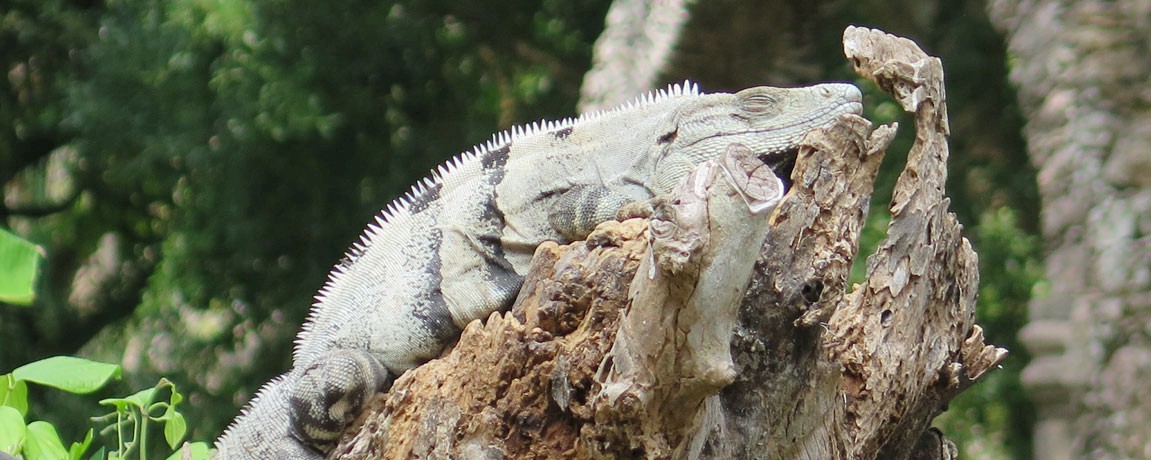

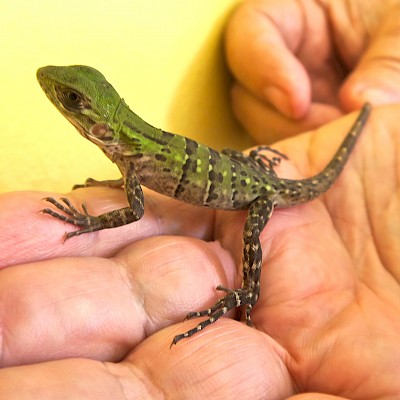
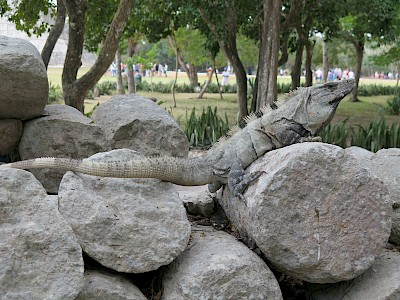
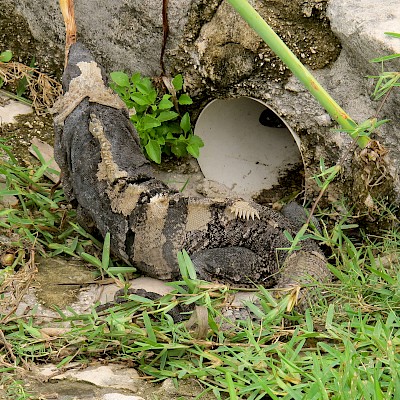
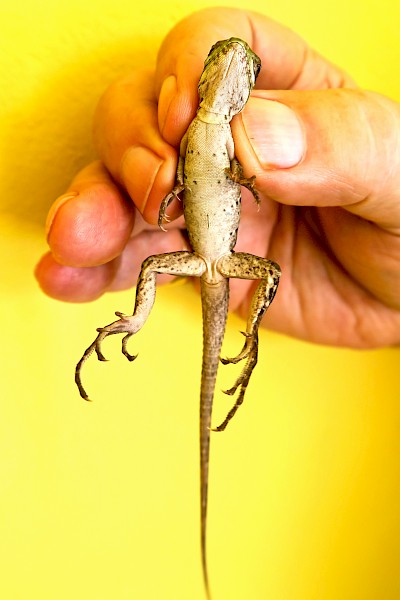
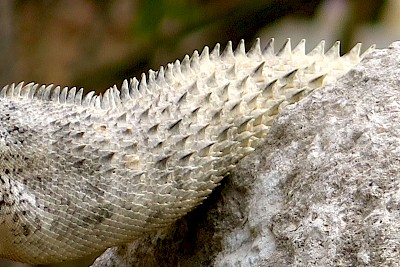
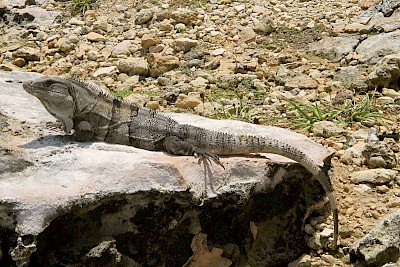
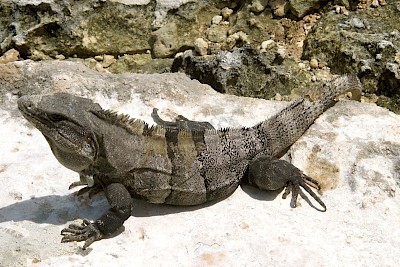
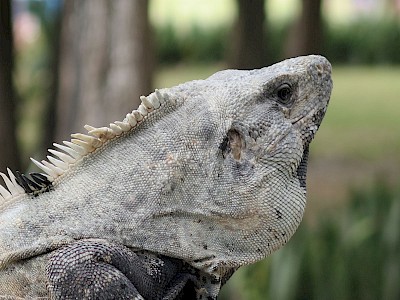
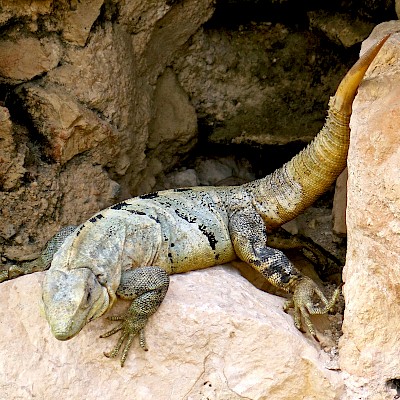
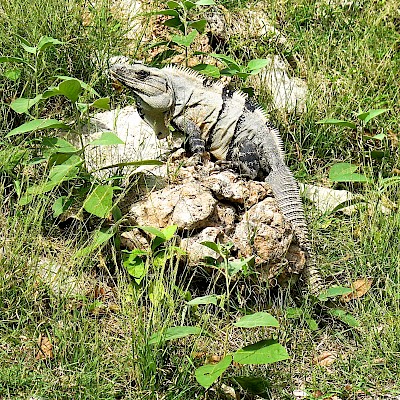
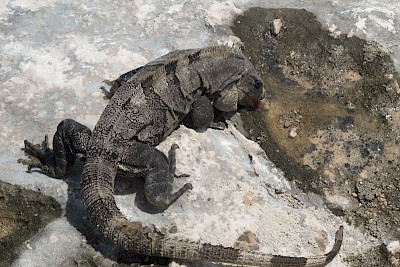
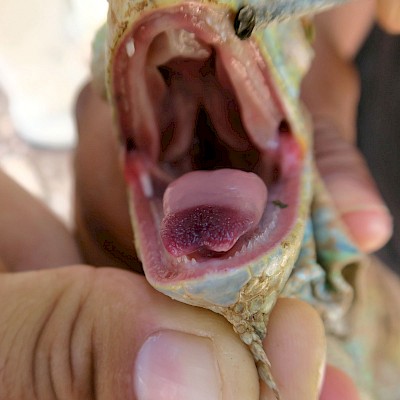
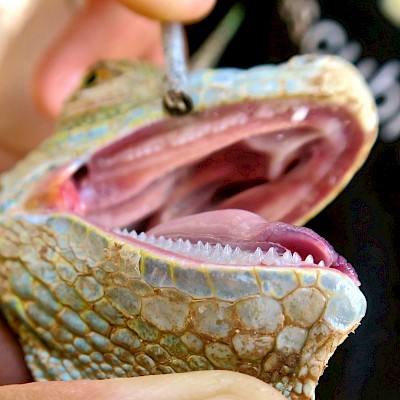
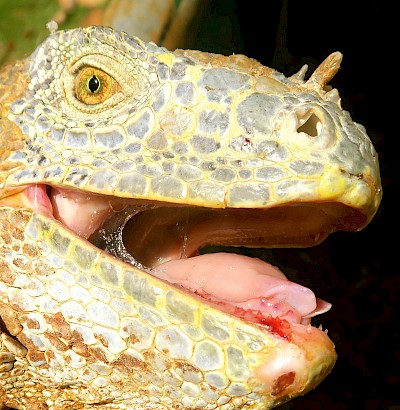
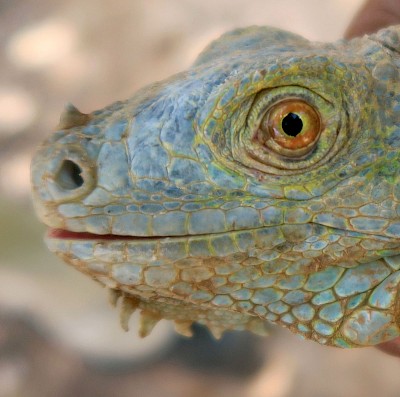
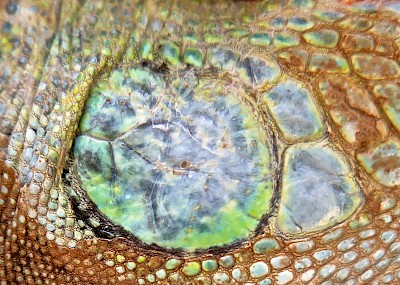
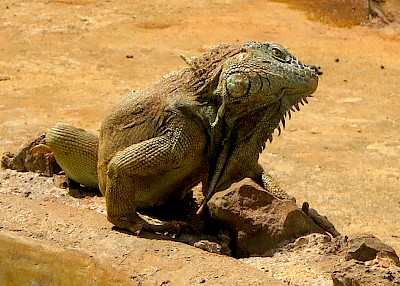
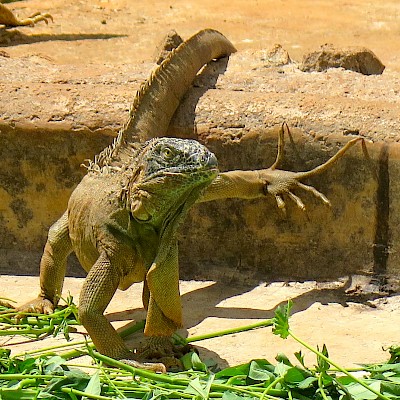
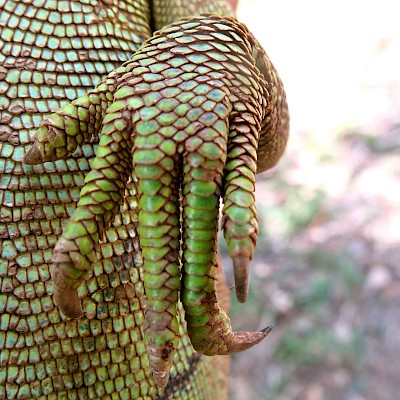
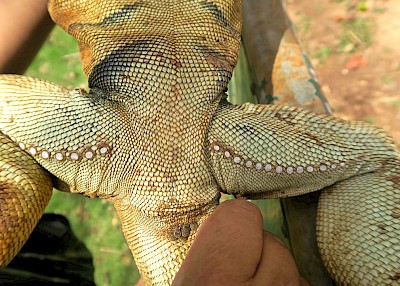
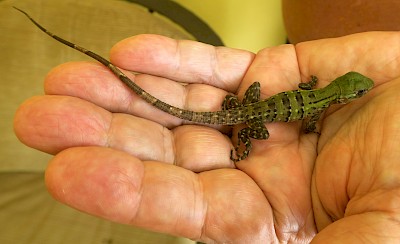
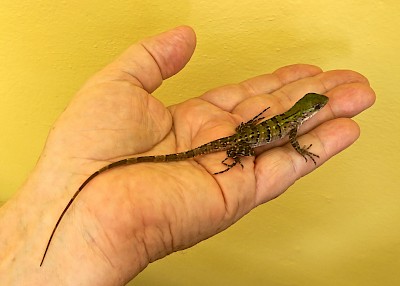

Comments
Byron Augustin 8 years ago
Mr. McFerran:
I am sorry to be so regrettably late with my response. Some urban residents have had success with attracting iguanas to compost piles where soft, nearly spoiled fruit like papayas and bananas are favorites. However, they have to have some rock location or rock walls that attract them in the first place. Thank you for commenting on the article.
Byron Augustin
Reply
Joe McFerran 8 years ago
Great series of articles!
Any tips for encouraging iguanas to visit our yard? (We have a large backyard on the edge of Centro with lots of trees.)
Thanks.
Reply
The Working Grilla 8 years ago
Ahh. Aside from flowers, I haven't really seen them devour anything myself. We messaged Mr. Augustin to see if he had any recommendations!
Reply
(0 to 3 comments)